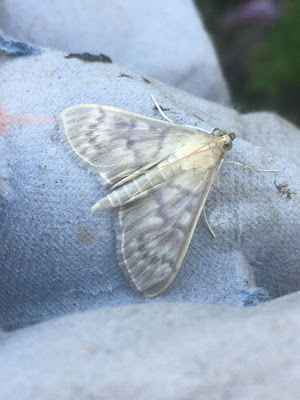Presumably it went into a dive after a particularly juicy moth and either couldn't pull out in time or was so overcome with greed, or hunger, that the powerfully deterrent effect of light on bats didn't work. I also wondered if its famous radar might have been distracted by the lamp, as may happen with moths (the opposite of being 'attracted' to light, which they are often said to be). But when I reported the event on the omniscient Upper Thames Moths blog, Martin Townsend who co-wrote the Moth Bible, commented that he had never heard of a bat roosting in a trap and described the incident as 'amazing'. If distraction-by-light had been responsible, the same would have happened to other bats.
Aware of the super-protection enjoyed by bats, I placed the eggbox carefully in our shed (the bat stirred very slightly so I was reassured that it was alive) and left the door and windows open. By nightfall the furry little visitor was gone. I often see bats at dusk but our only previous close encounter was when a Noctule flew into one of our big windows and we found its little body - most UK bats really are tiny when their wings are furled - on the ground outside. Pics below:
As for the moths, I was interested to find a couple of Small Magpie micros both of which, rather unusually, shared the pearlescent sheen of the Mother of Pearl shown after them below:
Two other agreeable micros also caught my eye: this Endotricha flammealis below and, finishing off today's post, the discreetly marked purple beauty, Hypsopygia glaucinalis.









What an amazing find in your trap. I have heard of it happening before but must be a pretty rare event. Some nice smart micros-ones I can actually identify!
ReplyDeletehi there and apols for the delay in getting back to you. Yes, apparently it doesn't happen often. I'm waiting to hear back from the Oxfordshire Bat Group and will do an update in due course. Did you read about the puffin on my next post? That really was amazing!
ReplyDeleteAll warmest
M